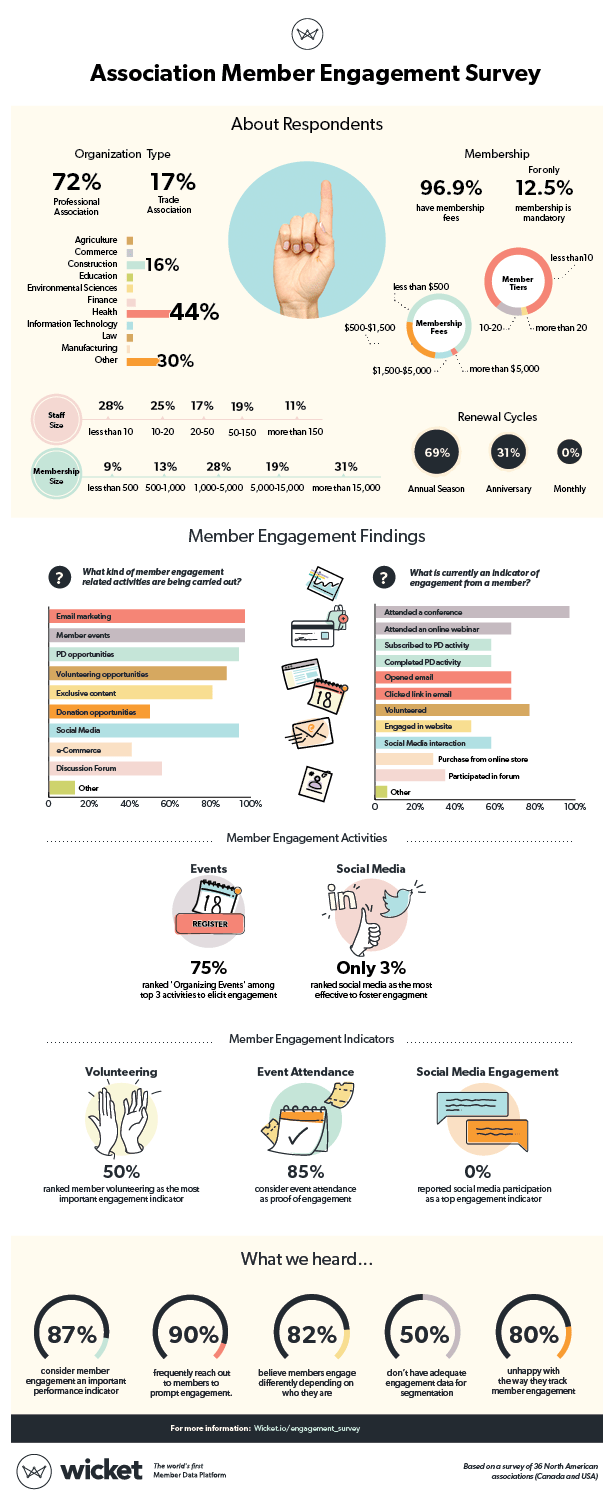Association Member Engagement – A Research Survey

At the core of every association, there is a clear mandate to understand their members and keep them engaged. Engagement is the result of an association that understands the needs of their members and offers them information, education, support and other services that fulfill those needs. Because of that, measuring engagement becomes the equivalent of measuring the health pulse of an association.
Related Reading:
- Member Engagement Score for Associations
Wicket’s approach to member engagement scoring based on the outcomes of this research survey - Association Member Engagement Research Survey Infographic
Download the infographic from our research survey in PNG format
The challenge of measuring member engagement
Accurately and consistently measuring member engagement is a difficult task. The challenge starts with defining what an engaged member looks like. There is no one definition of an engaged member that applies to all associations. In fact, there is no one definition that fits even all the members within a single association. The picture of engagement can look very different and change depending on the type of member and possibly the demographic group they are part of.
Furthermore, associations are faced with a moving target, which changes over time. The perception and expectation of what the organizations should provide changes over the lifespan of the member’s professional career.
Often, attempts to identify and update this definition of engagement requires organizations to constantly ask members what they are looking for or what they expect from the association. This puts a lot of burden on members to continuously state their needs and makes them feel like the organization never truly gets to know who they are, which diminishes the value of the membership itself.
In an ideal scenario, organizations could focus on having a meaningful dialogue with their members that is context-aware and focused on the objectives the member seeks at that point in time. In this way, the association can collect valuable and actionable qualitative information at the level of individual members. To complement that, associations could observe the member’s behaviour and infer meaning from the underlying data trail of those interactions, without having to ask members about it. This would be the quantitative dimension of the full picture of member engagement that associations seek.
To get there, it is important to gain insights that can feed the process of defining a member engagement framework, which can then be supported and implemented by technology. In this article, we present the first steps Wicket has taken to gain those insights.
The research survey
Since Wicket strives to support organizations in their journey to maximize value for their members, we set the goal of furthering our knowledge about member engagement. We also wanted to test some of our assumptions about how associations think and act on the topic. For this purpose, we designed a research survey that focused on understanding the activities that associations perform to engage members as well as to identify and prioritize the engagement indicators that they deem to be important.
The survey was divided into three major sections. The first section of the survey focused on questions regarding meta-data about the organization. This included the type of association, sector of member practice, organization size (staff and membership), and membership structure (tiers, fees, schedule etc.). This information was meant to understand the context of respondents and to support further pivoting or segmentation of data. Our findings on these questions are summarized in the section titled “About survey respondents” below.
The second section focused on member engagement. There were essentially two questions on this topic with one additional follow-up question each.
The first question and follow-up:
“ What kind of member engagement related activities are carried out by your membership management staff: ”
“From your answers to the previous question, please indicate – from your experience – which activities are more effective in fostering member engagement. Order your answers from the most effective at the top to the least effective at the bottom.”
The second question and follow-up:
“Please indicate which of the following are currently an indicator of engagement from a member for your organization. Please select only those that apply today for your organization:”
“From your answers to the previous question, please order your answers in order of importance as an engagement indicator for your organization. Place the most important at the top.”
These two questions and the corresponding follow-ups were designed to first capture what organizations are currently doing, and how effective they see those efforts to be in drawing member engagement. Second, to understand what they actually consider to be engagement indicators, and which are more or less important to them. Our discussion on the answers to these questions can be found under the title “Member engagement results” further down.
The questions in section three focused on validating our assumptions about the importance of member engagement and to assess the degree to which organizations feel they have resolved the issue or not. The last question in this section was an open question to collect qualitative feedback and for participants to express how having access to an objective measurement of member engagement would impact their organization. See the section titled “Validating our assumptions” for more details.
In the next sections, we discuss our findings and highlight some interesting data points.
About survey respondents
We received responses from 36 North American associations (Canada and USA). Although the respondents were predominantly professional associations in the health sector (44%), we had representation for other sectors like education, environmental science, finance, construction, manufacturing, and commerce.
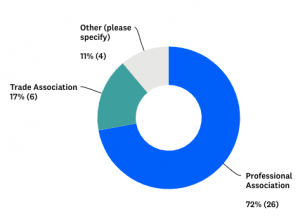
In terms of the type of organizations, 72% were professional associations, 17% trade associations, and 11% others (i.e. Certifying body, non-profit, bar association and healthcare NGO).
The size of the organizations varied by staff size (from less than 10 full-time staff to more than 150) and by membership size (from less than 500 members to more than 15,000).
Having an active membership is only mandatory for professionals working in 12% of these organizations and for 97% of them, membership requires a fee.
With regards to the membership schedule, 63% of these associations have a renewal cycle based on a fixed term yearly season, and 31% have anniversary based renewals while none had a monthly renewal schedule.
The vast majority (84%) have less than 10 membership tiers and for 63% of them, the fee is less than $500 dollars.
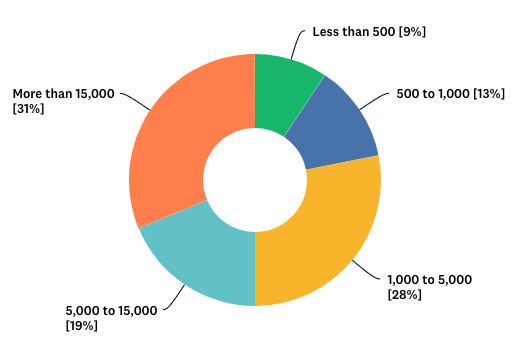
Number of members 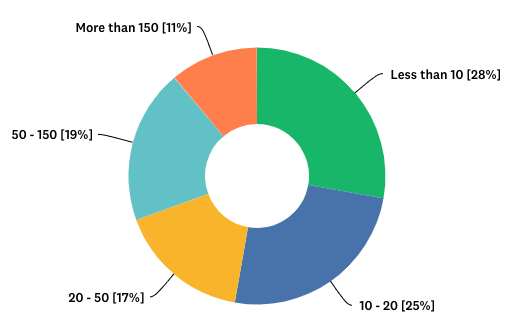
Number of full-time staff
Member engagement results
In the next sections, we present and discuss the answers for the two main questions of the survey related to member engagement activities, indicators, their effectiveness and importance.
Member engagement activities
In terms of the main activities that the respondents reported, we can see that 97% are doing email marketing communications and organizing events. Those are followed closely by offering professional development opportunities and doing social media engagement activities. Additionally, a good number also reported offering volunteering opportunities (88%) and offering exclusive member-only content on their website (81%).
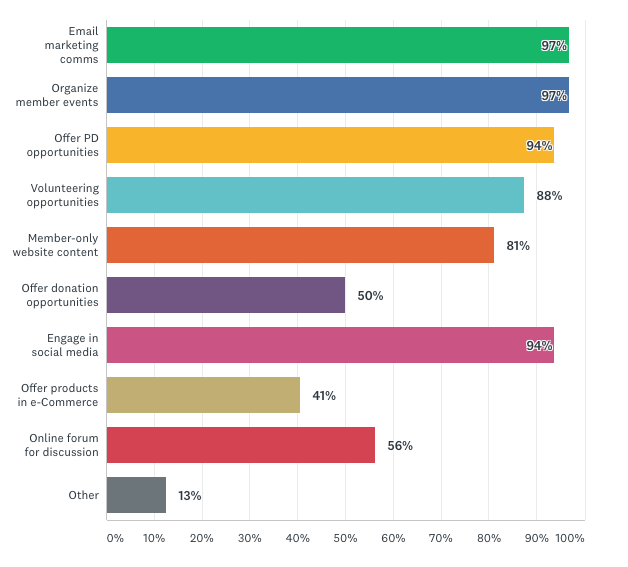
From this data, we can see there is a somewhat even spread of the top 6 types of activities. One thing to keep in mind is that this does not reflect the amount of effort or time spent in each one of those activities.
Next, we asked about the effectiveness of those activities in driving member engagement. Organizations sorted the activities they currently perform from the most effective (1st) to the least effective (10th).
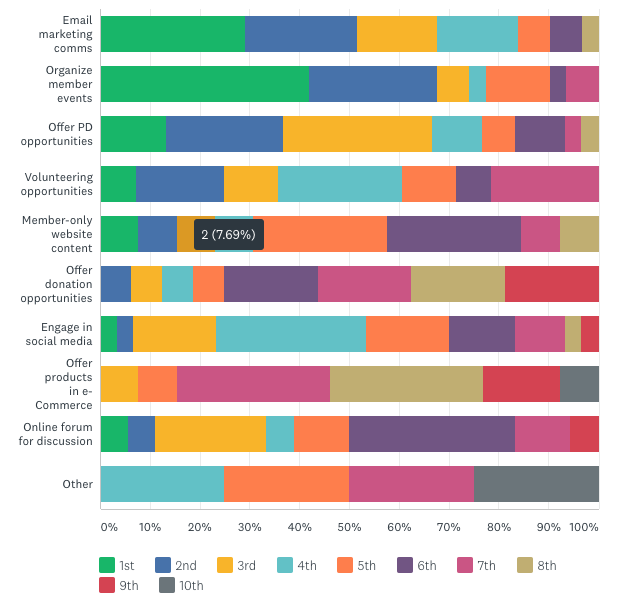
This chart shows the distribution of answers by ranking given to each activity individually. Because we asked respondents to rank only the activities they perform, instead of all activities available as answers to the first question, we should not attempt to compare the individual distribution values across activities (i.e. different number of people ranked each activity).
What this chart does show is how multiple organizations that do perform a certain activity ranked it among themselves. For example, we can observe that among the associations organizing member events, 42% of them rank it as the most effective (green block), while another 26% rank it as the second most effective (blue block) and 6% ranked it in 3rd place (yellow block). This shows that this is a very effective practice according to those organizations that carry out this activity (i.e. 74% ranked it among the top 3 places for effectiveness).
Another example is social media communications. From the first question, we saw that 94% of the associations report doing this activity. However, in this chart, we can observe that only 3% of them placed it in 1st place for effectiveness. It would be an interesting exercise to hypothesize about the reasons for this. It could be that measuring the results of social media activity is harder to quantify and observe in a tangible way.
Member engagement indicators
One thing is to look at what associations are doing and with what perceived effectiveness, but another is about what they consider today as engagement indicators and how important they are (independently of the current capabilities to measure them). The former relates to taking action, the latter is about measuring results.
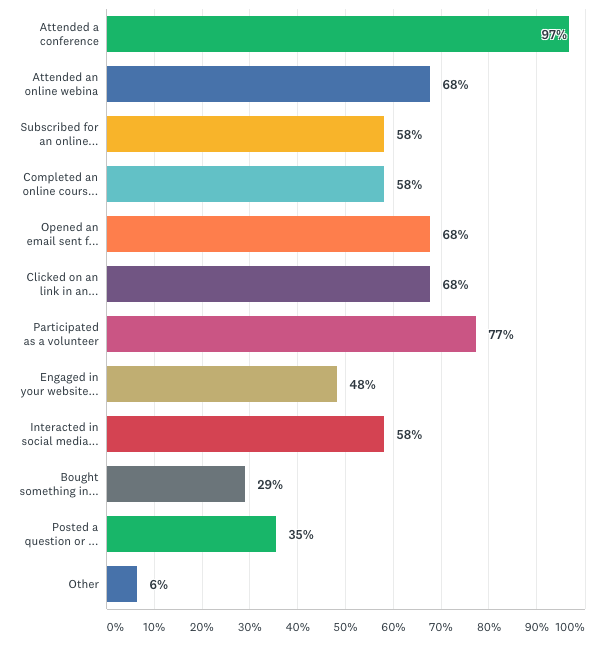
What we immediately observe is an overall decrease in the percentage of organizations that consider the corresponding member activity an engagement indicator. The clear exception to this was around events. In that case, 97% of associations reported organizing events, and all 97% of them consider conference attendance as an engagement indicator for their organization.
For all other categories, the numbers are lower in the engagement indicator than in the activity participation. In particular, for social media and professional development, the numbers go from 94% of associations offering those activities to 58% of them considering member participation in social media or PD activities as an engagement indicator.
Similarly, email marketing goes from 97% of associations doing that activity to only 68% considering email opens as engagement indicators. Perhaps associations view email marketing as a more transactional activity where email opens do not possess a lot of value as engagement data.
In contrast, volunteering seems to be more consistent in terms of activity vs engagement indicator (88% vs 77%). Interestingly, a member participating as a volunteer came in second place as a reported engagement indicator, however, it came 5th in the number of organizations that reported offering such opportunities. The value of volunteering activities is further enforced in the answers to the next question, which asked respondents to rank the engagement indicators based on their importance.
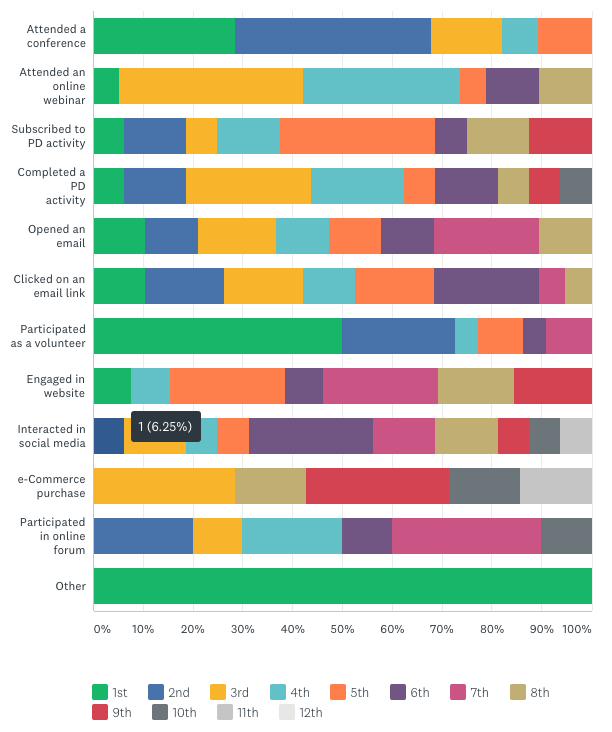
From 88% of associations that reported offering volunteering opportunities, 50% of them ranked member volunteering as the most important engagement indicator, with an additional 22% placing it at 2nd place. Similarly, conference attendance was reinforced as a focal point for engagement, with almost 85% of respondents that consider it an engagement indicator placing it at the top three places for importance.
Again, social media activity fell in the numbers. None of the 94% of associations doing this activity (nor the 58% that consider it engagement) ranked it in the first place of importance as an engagement indicator.
Validating our assumptions
In principle, it is very easy to argue about the importance of member engagement, and assume that it is a problem that needs to be solved. However, we wanted to validate this assumption by directly asking associations about it.
The specific questions we asked and the full results can be found in our survey results infographic. However, here we present a summary of our findings:
- 87% of respondents consider member engagement as an important performance indicator for their organization.
- 90% report frequently reaching out to members to prompt engagement.
- 82% believe that members display engagement behaviour differently depending on the type of member they are or the demographic group they belong to, which enforces the case for having segmentation tools.
- 50% believe they don’t have the necessary means to create adequate member segmentation based on engagement data, 28% are not certain if they do, while only 20% believe they have the ability to address segmented groups by engagement data.
- Finally, almost 80% reported not being happy with the way they currently track member engagement in their organization, with 10% undecided and only 10% feel comfortable with their situation.
Qualitative feedback
The last question of the survey asked participants to answer the following question:
“Imagine you could have an objective measure of how engaged your members are overall, and you could get details about how individual members are actively engaging (or not) with your organization. What would be the impact of accessing this information in your organization? Please share your thoughts.”
We reviewed people’s answers and categorized the benefits of having access to such data:
- Improved ability to adjust programs and events
- Ability to tailor services to segments and individuals
- Improve value proposition with a more efficient business model
- Development of prediction models of retention
- Advanced segmentation that places members in groups according to the level of engagement.
- Factual decisions made based on hard data, instead of an emotional, gut or reactive decision making
- Save time and money while defining engagement strategies
- Targeted communications at a lower level of granularity
- Follow up with disengaged members directly
- Anticipate member behaviour and needs
- Establish correlation between association activities and the reduction of churn
- Apply lessons learned from one group to another.
Some of the feedback focused on the challenges of getting to the point where that data is available and can be acted upon effectively:
- Concerns about justifying the investment in putting technology in place to track and process the data
- Fear of having too much data and not acting on it to drive business decisions
- Risk of introducing organizational bias to the definition of engagement, instead of having a model that is based on the member’s criteria of what high engagement means for them
- A cautionary note about collecting negative feedback too, not just positive engagement indicators.
Summary
We surveyed 36 North American associations to gather their thoughts concerning member engagement. Our goal was focused on understanding the activities that associations perform to engage members, gauge which ones are perceived as being more effective, as well as to identify and prioritize the engagement indicators that they deem to be important.
The results confirmed our assumption that having an objective measurement of member engagement as a pulse of the health of the association is a common problem and a challenge. Associations are not happy with their current approach to this problem and they agree that solving it would bring a lot of benefits to their membership operations.
According to the responses from the surveyed organizations, the two most common activities, that associations carry-out, are email marketing communications and organizing member events (e.g. conferences). We identified social media as a common activity that associations do, however, most of them do not consider this an effective practice to drive engagement nor they feel like it is an important engagement indicator at the moment and with the tools available to them.
Volunteering, on the other hand, seems to be an underestimated way of engaging members. The practice of offering those opportunities to members is not as wide-spread as other activities carried out by associations, however, those who do offer them report that it is an effective practice and an important indicator of member engagement.
We also realized that there is a general tendency to carry-out a widespread range of activities, but less certainty about how to measure the effects of their efforts (i.e. which engagement indicators are adequate to measure the impact of those activities).
With this survey, we have discovered a number of insights that will feed our thought process as we shape our roadmap around product features that support associations in understanding their members and their level of engagement with the organization.
